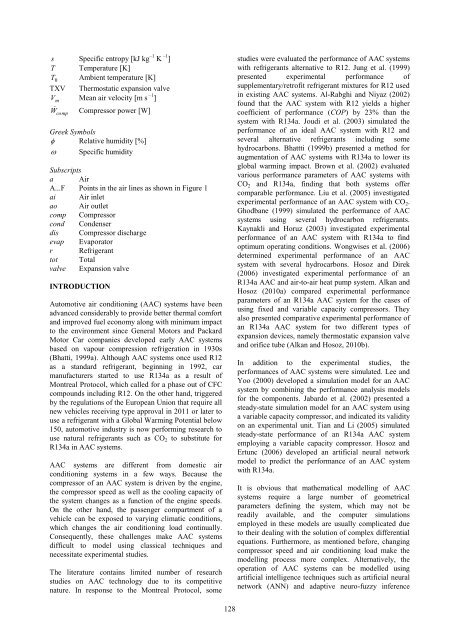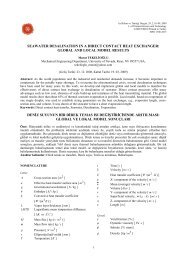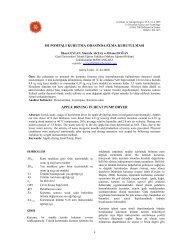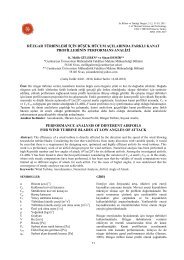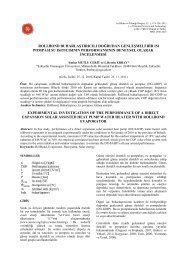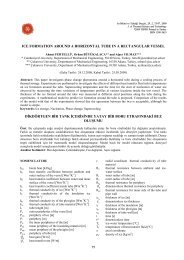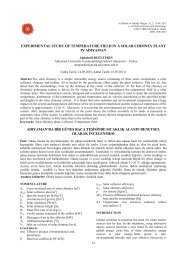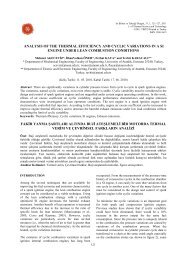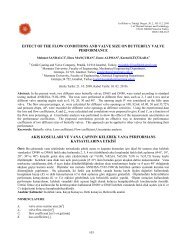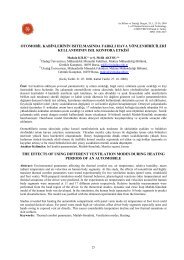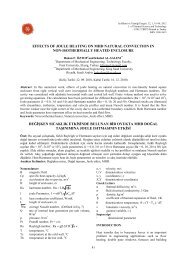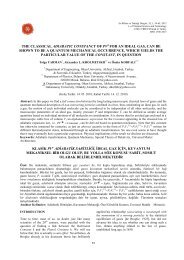modelling of an automotive air conditioning system using anfis
modelling of an automotive air conditioning system using anfis
modelling of an automotive air conditioning system using anfis
Create successful ePaper yourself
Turn your PDF publications into a flip-book with our unique Google optimized e-Paper software.
s Specific entropy [kJ kg –1 K –1 ]<br />
T Temperature [K]<br />
T 0 Ambient temperature [K]<br />
TXV Thermostatic exp<strong>an</strong>sion valve<br />
V Me<strong>an</strong> <strong>air</strong> velocity [m s –1 ]<br />
m<br />
W comp Compressor power [W]<br />
Greek Symbols<br />
Relative humidity [%]<br />
Specific humidity<br />
Subscripts<br />
a Air<br />
A...F Points in the <strong>air</strong> lines as shown in Figure 1<br />
ai Air inlet<br />
ao Air outlet<br />
comp Compressor<br />
cond Condenser<br />
dis Compressor discharge<br />
evap Evaporator<br />
r Refriger<strong>an</strong>t<br />
tot Total<br />
valve Exp<strong>an</strong>sion valve<br />
INTRODUCTION<br />
Automotive <strong>air</strong> <strong>conditioning</strong> (AAC) <strong>system</strong>s have been<br />
adv<strong>an</strong>ced considerably to provide better thermal comfort<br />
<strong>an</strong>d improved fuel economy along with minimum impact<br />
to the environment since General Motors <strong>an</strong>d Packard<br />
Motor Car comp<strong>an</strong>ies developed early AAC <strong>system</strong>s<br />
based on vapour compression refrigeration in 1930s<br />
(Bhatti, 1999a). Although AAC <strong>system</strong>s once used R12<br />
as a st<strong>an</strong>dard refriger<strong>an</strong>t, beginning in 1992, car<br />
m<strong>an</strong>ufacturers started to use R134a as a result <strong>of</strong><br />
Montreal Protocol, which called for a phase out <strong>of</strong> CFC<br />
compounds including R12. On the other h<strong>an</strong>d, triggered<br />
by the regulations <strong>of</strong> the Europe<strong>an</strong> Union that require all<br />
new vehicles receiving type approval in 2011 or later to<br />
use a refriger<strong>an</strong>t with a Global Warming Potential below<br />
150, <strong>automotive</strong> industry is now performing research to<br />
use natural refriger<strong>an</strong>ts such as CO 2 to substitute for<br />
R134a in AAC <strong>system</strong>s.<br />
AAC <strong>system</strong>s are different from domestic <strong>air</strong><br />
<strong>conditioning</strong> <strong>system</strong>s in a few ways. Because the<br />
compressor <strong>of</strong> <strong>an</strong> AAC <strong>system</strong> is driven by the engine,<br />
the compressor speed as well as the cooling capacity <strong>of</strong><br />
the <strong>system</strong> ch<strong>an</strong>ges as a function <strong>of</strong> the engine speeds.<br />
On the other h<strong>an</strong>d, the passenger compartment <strong>of</strong> a<br />
vehicle c<strong>an</strong> be exposed to varying climatic conditions,<br />
which ch<strong>an</strong>ges the <strong>air</strong> <strong>conditioning</strong> load continually.<br />
Consequently, these challenges make AAC <strong>system</strong>s<br />
difficult to model <strong>using</strong> classical techniques <strong>an</strong>d<br />
necessitate experimental studies.<br />
The literature contains limited number <strong>of</strong> research<br />
studies on AAC technology due to its competitive<br />
nature. In response to the Montreal Protocol, some<br />
studies were evaluated the perform<strong>an</strong>ce <strong>of</strong> AAC <strong>system</strong>s<br />
with refriger<strong>an</strong>ts alternative to R12. Jung et al. (1999)<br />
presented experimental perform<strong>an</strong>ce <strong>of</strong><br />
supplementary/retr<strong>of</strong>it refriger<strong>an</strong>t mixtures for R12 used<br />
in existing AAC <strong>system</strong>s. Al-Rabghi <strong>an</strong>d Niyaz (2002)<br />
found that the AAC <strong>system</strong> with R12 yields a higher<br />
coefficient <strong>of</strong> perform<strong>an</strong>ce (COP) by 23% th<strong>an</strong> the<br />
<strong>system</strong> with R134a. Joudi et al. (2003) simulated the<br />
perform<strong>an</strong>ce <strong>of</strong> <strong>an</strong> ideal AAC <strong>system</strong> with R12 <strong>an</strong>d<br />
several alternative refriger<strong>an</strong>ts including some<br />
hydrocarbons. Bhattti (1999b) presented a method for<br />
augmentation <strong>of</strong> AAC <strong>system</strong>s with R134a to lower its<br />
global warming impact. Brown et al. (2002) evaluated<br />
various perform<strong>an</strong>ce parameters <strong>of</strong> AAC <strong>system</strong>s with<br />
CO 2 <strong>an</strong>d R134a, finding that both <strong>system</strong>s <strong>of</strong>fer<br />
comparable perform<strong>an</strong>ce. Liu et al. (2005) investigated<br />
experimental perform<strong>an</strong>ce <strong>of</strong> <strong>an</strong> AAC <strong>system</strong> with CO 2 .<br />
Ghodb<strong>an</strong>e (1999) simulated the perform<strong>an</strong>ce <strong>of</strong> AAC<br />
<strong>system</strong>s <strong>using</strong> several hydrocarbon refriger<strong>an</strong>ts.<br />
Kaynakli <strong>an</strong>d Horuz (2003) investigated experimental<br />
perform<strong>an</strong>ce <strong>of</strong> <strong>an</strong> AAC <strong>system</strong> with R134a to find<br />
optimum operating conditions. Wongwises et al. (2006)<br />
determined experimental perform<strong>an</strong>ce <strong>of</strong> <strong>an</strong> AAC<br />
<strong>system</strong> with several hydrocarbons. Hosoz <strong>an</strong>d Direk<br />
(2006) investigated experimental perform<strong>an</strong>ce <strong>of</strong> <strong>an</strong><br />
R134a AAC <strong>an</strong>d <strong>air</strong>-to-<strong>air</strong> heat pump <strong>system</strong>. Alk<strong>an</strong> <strong>an</strong>d<br />
Hosoz (2010a) compared experimental perform<strong>an</strong>ce<br />
parameters <strong>of</strong> <strong>an</strong> R134a AAC <strong>system</strong> for the cases <strong>of</strong><br />
<strong>using</strong> fixed <strong>an</strong>d variable capacity compressors. They<br />
also presented comparative experimental perform<strong>an</strong>ce <strong>of</strong><br />
<strong>an</strong> R134a AAC <strong>system</strong> for two different types <strong>of</strong><br />
exp<strong>an</strong>sion devices, namely thermostatic exp<strong>an</strong>sion valve<br />
<strong>an</strong>d orifice tube (Alk<strong>an</strong> <strong>an</strong>d Hosoz, 2010b).<br />
In addition to the experimental studies, the<br />
perform<strong>an</strong>ces <strong>of</strong> AAC <strong>system</strong>s were simulated. Lee <strong>an</strong>d<br />
Yoo (2000) developed a simulation model for <strong>an</strong> AAC<br />
<strong>system</strong> by combining the perform<strong>an</strong>ce <strong>an</strong>alysis models<br />
for the components. Jabardo et al. (2002) presented a<br />
steady-state simulation model for <strong>an</strong> AAC <strong>system</strong> <strong>using</strong><br />
a variable capacity compressor, <strong>an</strong>d indicated its validity<br />
on <strong>an</strong> experimental unit. Ti<strong>an</strong> <strong>an</strong>d Li (2005) simulated<br />
steady-state perform<strong>an</strong>ce <strong>of</strong> <strong>an</strong> R134a AAC <strong>system</strong><br />
employing a variable capacity compressor. Hosoz <strong>an</strong>d<br />
Ertunc (2006) developed <strong>an</strong> artificial neural network<br />
model to predict the perform<strong>an</strong>ce <strong>of</strong> <strong>an</strong> AAC <strong>system</strong><br />
with R134a.<br />
It is obvious that mathematical <strong>modelling</strong> <strong>of</strong> AAC<br />
<strong>system</strong>s require a large number <strong>of</strong> geometrical<br />
parameters defining the <strong>system</strong>, which may not be<br />
readily available, <strong>an</strong>d the computer simulations<br />
employed in these models are usually complicated due<br />
to their dealing with the solution <strong>of</strong> complex differential<br />
equations. Furthermore, as mentioned before, ch<strong>an</strong>ging<br />
compressor speed <strong>an</strong>d <strong>air</strong> <strong>conditioning</strong> load make the<br />
<strong>modelling</strong> process more complex. Alternatively, the<br />
operation <strong>of</strong> AAC <strong>system</strong>s c<strong>an</strong> be modelled <strong>using</strong><br />
artificial intelligence techniques such as artificial neural<br />
network (ANN) <strong>an</strong>d adaptive neuro-fuzzy inference<br />
128


